During the last weekend of July 2018, Nintendo UK held the Nintendo UK VS: London event at the Royal Horticultural Society, which was attended by hundreds of fans. Among the highlights included the chance for fans to trial Super Smash Bros. Ultimate ahead of its 7th December launch and witness the first UK Super Smash Bros. Ultimate Invitationals played before their eyes.
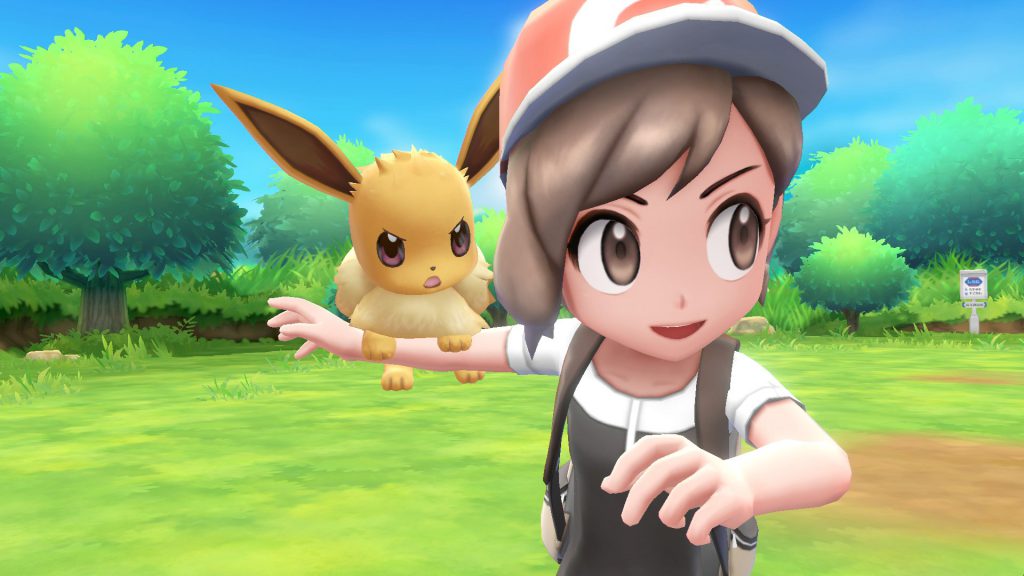
Pokémon Let’s Go, Pikachu and Eevee launch on 16th November 2018.
Amidst all of the Smash hype and excitement, there was a secret gem hidden behind the scenes. Literally. Behind the red curtains of the main event, there was a secret area that housed a playable demo of Pokémon Let’s Go, Pikachu! and Pokémon Let’s Go, Eevee! Only a select few press and Nintendo-related attendees were able to go inside and try out these elusive titles.
First announced back in May 2018, Pokémon Let’s Go, Pikachu and Eevee are the latest pair of Pokémon mainline RPGs, developed for the Nintendo Switch. They are inspired by Pokémon Yellow, following a new Pokémon trainer on their journey through the nostalgic Kanto region, and incorporate elements from Pokémon Go such as the catching mechanic.
To clear up all confusion, Let’s Go are fully fledged Pokémon adventures, with an entire region (Kanto) to explore, 150+ Pokémon to catch, gym leaders to conquer and dungeons to explore. So they aren’t simply “Pokémon Go for the Nintendo Switch”, although the very first trailer may have fooled you into thinking so.
Although there have been a few trailers and videos, Let’s Go Pikachu and Eevee are largely shrouded in secrecy, so it was extremely exciting to have the chance to personally experience these games. In fact, their presence was such a secret that even our demonstrator didn’t know the games would be present until the day before!
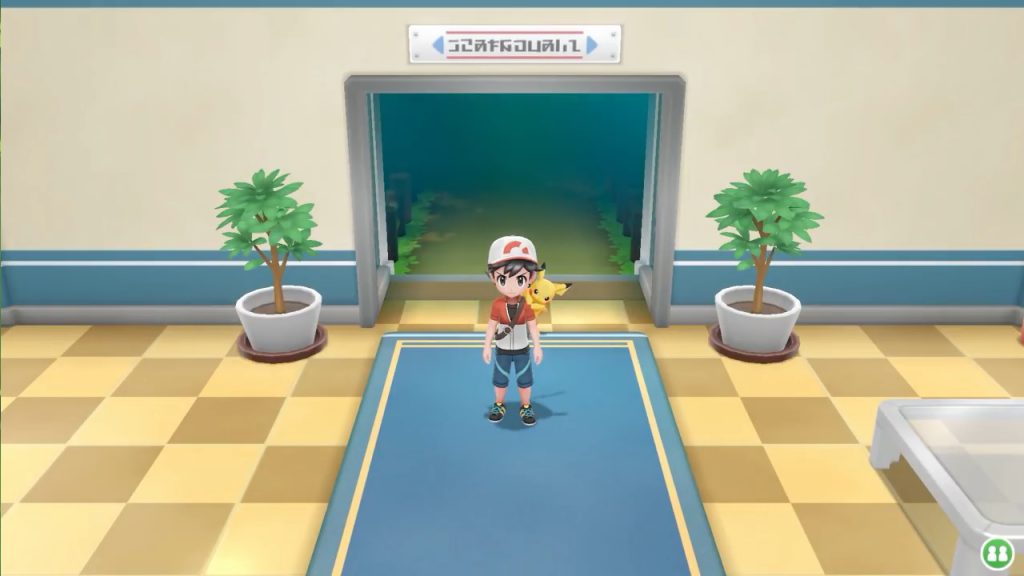
Our demo started from here. Going anywhere but directly north was a death sentence.
Not only that, but while we were playing, we had to follow a very strict playthrough–only being allowed to explore Viridian Forest, and we weren’t ever allowed to access the field menu. All the time, we were made aware that we were being watched. Not by Nintendo’s ninjas (although they were there), but by something far more sinister…
We could see them in the distance studying our every move: the hawks of the Pokémon Company. You see, there’s a very good reason there are very few legitimate Pokémon leaks. If anyone tries to uncover any Pokémon secrets early, these hawks will swoop in from their lofty peaks and silently drag them them away, never to be seen again. Or so we imagine anyway.
Furthermore, photography and videos were strictly forbidden. As such, all images in this article are taken from the Nintendo Treehouse demo at E3 2018 or other official sources. By the way, the E3 demo appears to be slightly different compared to the demo we played. Most notably the Pokémon in your party (which the developers presumably altered before this demo).
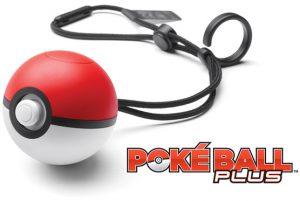
The Poké Ball Plus also doubles as a Pokémon Go Plus device.
As the demo began, we were equipped with our Poké Ball Plus, which is an optional controller shaped like a Poké Ball from the games. This device has a control stick in the middle of the ball, which can be pressed inwards to act as the A button. On top of the ball, on the red side, is a button that acts as B (and the menu button).
Despite some initial apprehensions, the Poké Ball Plus was a lot more comfortable than one might assume–and many others who played the demo shared our sentiments. The device felt great, like a high quality product (and it better had for its price!) and fit nicely in our hand. It also has a very balanced weight, so it’s not too light and not particularly heavy.
We started in the gatehouse to the south of Viridian Forest and were told to venture directly forward. Although we weren’t allowed to even explore the gatehouse, we did linger for a while with our headphones, and what we could hear of the background music (the event was very loud) was simply phenomenal, almost sounding like orchestrated music.
Sitting snugly on our shoulders was Pikachu, our partner Pokémon in Let’s Go Pikachu. Obviously, Eevee will be the partner Pokémon in Let’s Go Eevee. From the look of things, your partner cannot evolve, but you can catch and evolve ones from the wild. You can definitely catch Pikachu and we assume Eevee as well, otherwise it would be unfair.
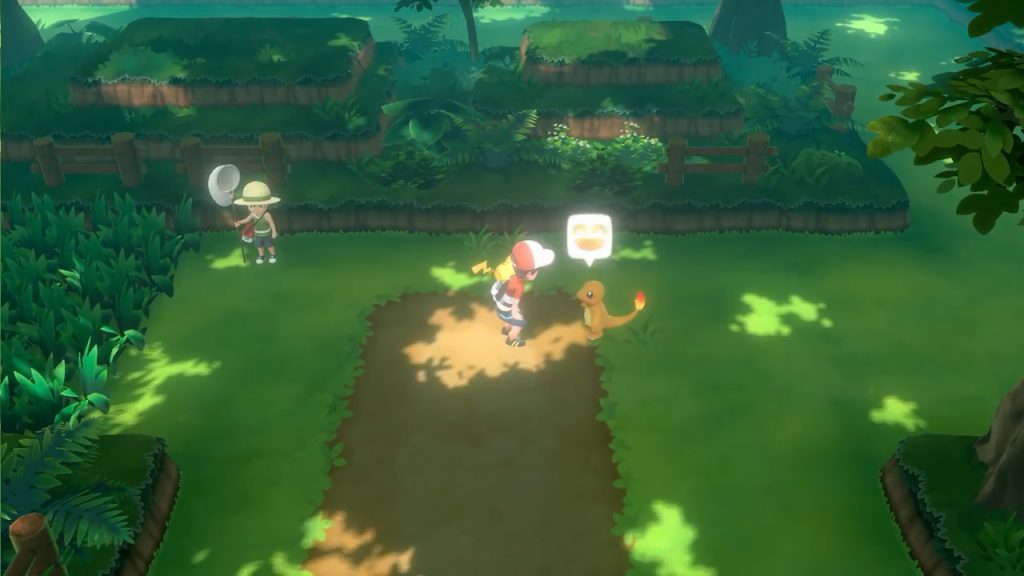
Your buddy’s responses change according to the location and situation.
Additionally, you can have a buddy Pokémon following you like in HeartGold and SoulSilver. In the demo, we had Charmander, but it can be any Pokémon, big or small. For certain big Pokémon, you ride them instead. You can speak to your buddy and your buddy will also act differently if there’s a hidden item (but we learned that afterwards).
Inside Viridian Forest itself, this was where Let’s Go Pikachu and Eevee’s visuals really shone. Online, the games have gotten a bit of flak for looking too simple compared to expectations, but honestly the graphics were very impressive. The colours were vivid and there were plenty of neat touches like the swaying grass and light illuminating from the canopies.
Combining the colourful location with an array of wandering wild Pokémon, Viridian Forest never felt more alive–and we’re excited to see how other Kanto locations will look and feel in 2018. Some people may have been expecting “Pokémon of the Wild” or compare the game to Yokai Watch 4, but Pokémon doesn’t need cutting edge graphics and what we saw on display more than sufficed.
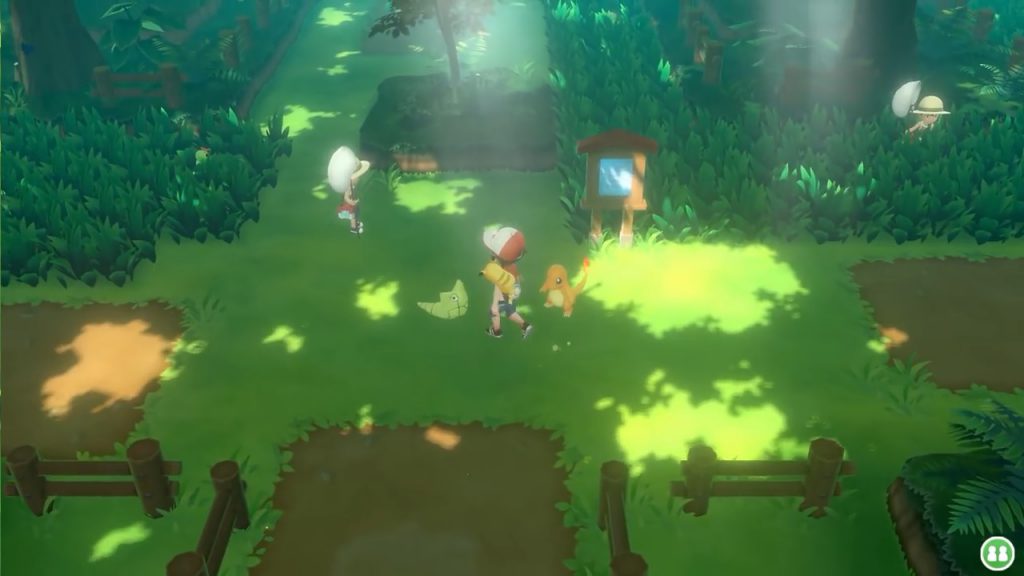
Wild Pokémon tend to spawn within the tall grass, but they can stray beyond.
Speaking of wild Pokémon, a new feature is that Pokémon appear on the field–and they can be battled by simply touching them, allowing you to choose which Pokémon to try and catch, and removing wild encounters entirely. We found this mechanic incredibly convenient and it’s bound to completely change the way you explore Kanto.
That said, it’s not uncommon for lots of wild Pokémon to group around near tall grass and even times when they spawned right in your path, so it might not be that easy to choose your path in practice. On the other hand, a few attendees found it too easy. So it might depend on your skill or maybe luck? Either way, we can see it being the future of the series.
In Let’s Go Pikachu, we encountered the likes of Pidgey, Caterpie, Metapod, Butterfree, Weedle, Kakuna, Oddish, Pikachu and Bulbasaur. Next to us, in Let’s Go Eevee, we saw Beedrill instead of Butterfree and Bellsprout instead of Oddish. In particular, Bulbasaur was really rare and we only saw a handful during both days.
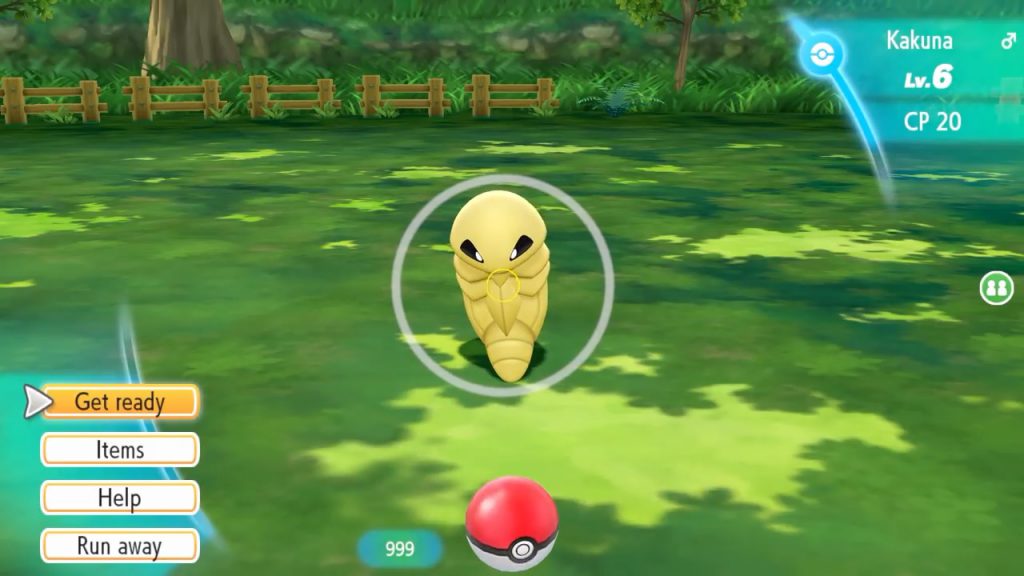
You need to select “Get Ready” each time you want to throw a ball.
After encountering a wild Pokémon, you don’t battle them like in previous Pokémon RPGs. Instead, you catch them like in Pokémon Go. First, you can choose “Items” to select your Poké Ball or a berry to add an effect, like easier capture. Then you select “Get Ready” to throw your Poké Ball by imitating the actual motion of throwing a ball.
This is where the Poké Ball Plus comes in–or a standard Joy Con controller if you prefer. It’s possible to do overhand and underhand throws. Or if you’re really good, you can twist your arm while pushing forward to do a corkscrew motion (which is probably equivalent to a curve ball from Go). You can also jerk left or right to throw the ball in that direction.
We only had 10 minutes or so to play the demo, so it’s difficult to really judge the precision of the catching. However it might require some practice, a bit like Pokémon Go, unsurprisingly. One thing we found is that it doesn’t seem to matter how you point the controller. You can easily throw straight ahead by standing at right angles from the screen (which we did).
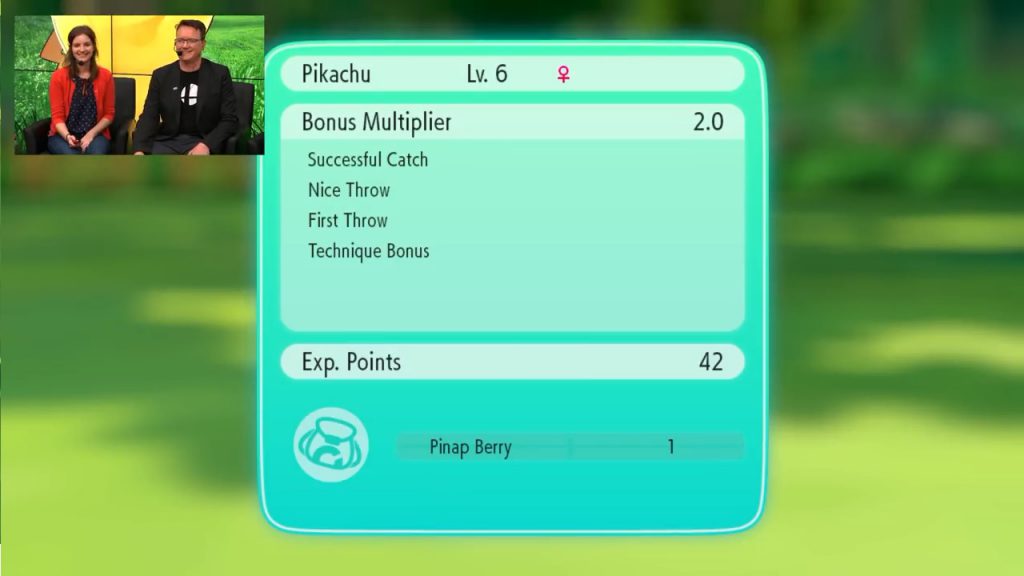
The multipliers encourage trainers to get better at chucking Poké Balls.
After catching a wild Pokémon, you earn experience points like in X, Y, Sun, Moon etc. You also get experience multipliers depending on factors like catching the Pokémon on your first try, scoring an Excellent (by throwing the ball when the circle target is really small), for your technique (presumably curve balls and the like), etc.
So the better you are at catching Pokémon, the quicker your Pokémon get stronger. Most of the time, we only got small multipliers. However we did see another attendee rack up several multipliers for a 10+ multiplier, giving all his Pokémon two level ups (Exp. Share was active for the demo). Although that’s probably not something you’d get all the time!
Back to wild Pokémon for a moment, roaming around the forest were Pokémon with red and blue swirly auras. These weren’t particularly rare in the demo. Red Pokémon were huge, while blue were tiny. No matter the size, they gave additional experience bonuses after being caught. Besides that, we’re not sure what they do, except for maybe bragging rights?
For real bragging rights though, it’s a little known fact that Let’s Go Pikachu and Eevee will feature rare shiny Pokémon. This might be obvious since you can transfer Pokémon from Pokémon Go to these games–and Pokémon Go features shinies. During the weekend, we actually saw an attendee catch a shiny Pidgey. Shiny Pokémon have sparkles while on the field.
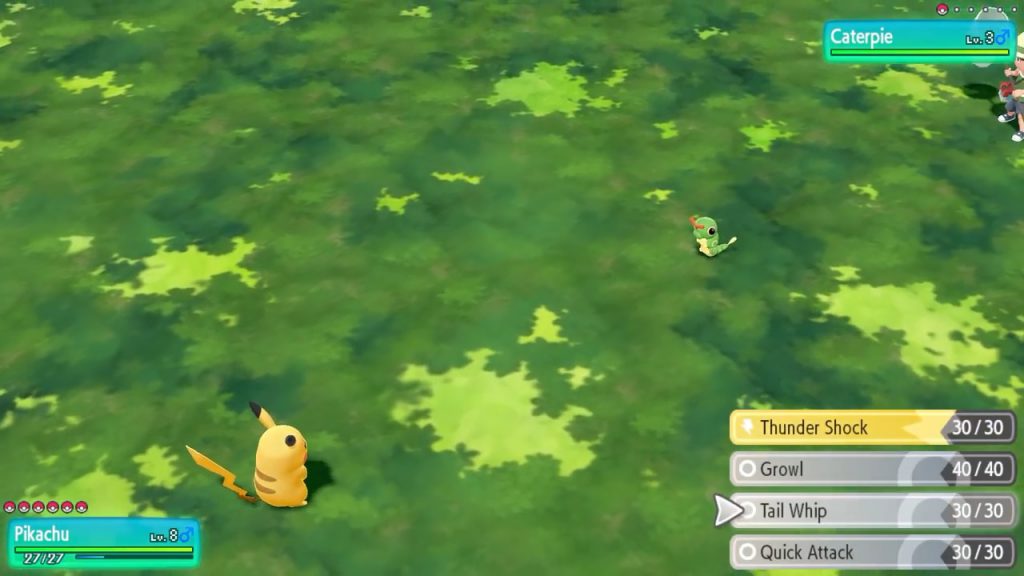
The battles use a dynamic camera like in Sun and Moon.
While you can’t directly battle wild Pokémon, battles with Pokémon trainers are the same as ever. So you can still choose from up to 4 moves, switch Pokémon, use items etc. Our Pokémon party consisted of Pikachu, Bulbasaur, Charmander, Squirtle, Meowth and Eevee. It’s likely this team isn’t representative of the actual game.
When switching Pokémon, you can view their stats (HP, Atk, Def, Sp. Atk, Sp. Def and Spd) and markings (the 6 symbols you can give to Pokémon). There was also a type-themed background, so Charmander had a fiery background for example. More importantly, we didn’t spot any Abilities–but it is just the demo, so they might just be hidden for now.
The battle animations looked similar to previous handheld installments, but spiced up; the battles were very reminiscent of Pokémon Stadium etc. The Pokémon trainers also stand in the background, like in Sun and Moon. In fact, the trainer animations look almost identical (like the fingers on the chin), which was kind of cute, but some might call it lazy.
Move-wise, nothing seemed too out of the ordinary. Early on, Bulbasaur learns Leech Seed, Charmander learns Smokescreen, Squirtle learns Bubble and Pikachu learns Quick Attack. One big difference we noticed was that Meowth has (or learns) Bite and Fake Out early on and learns Taunt in the teens. But this could all change.
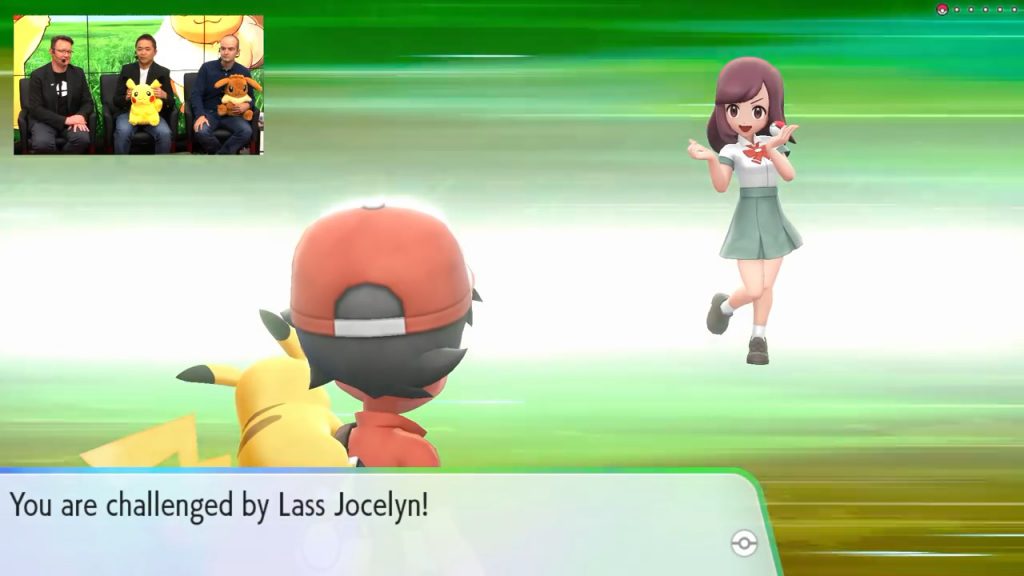
The character designs look really well-designed; we can’t wait to meet the other trainers!
The trainers we fought were standard fare early-game trainers. So Bug Catchers with Caterpie, Kakuna and Metapod and Lasses with Pidgey and Rattata. There were about seven trainers in total, although we didn’t really keep count. The layout of the forest was basically identical to what we remember from Yellow, but no items were present during the demo.
All in all, in our 10 minutes, we came out thoroughly impressed by the scope of the games. Pretty much everyone we watched also felt excitement for the games. In particular, there were two children who seemed enthralled with the game and all too keen to pretend to be a Pokémon trainer, catching Pokémon with their real life Poké Ball.
We have a strong suspicion that the games will light up the charts come Christmas time, as children and “big” children are enraptured by this renewed Pokémon adventure. For those still on the fence, hopefully they’ll release a public demo like with Sun and Moon. Otherwise, there’s always the next generation Pokémon RPG scheduled for 2019.
PS: In all seriousness, the reps from the Pokémon Company were actually extremely friendly. Please don’t hurt us, ahhhh!